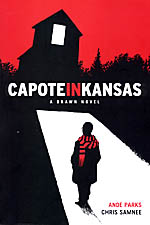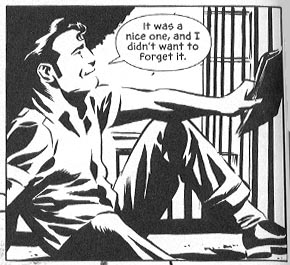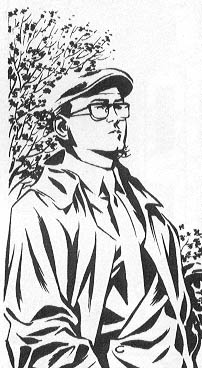 Written by Ande Parks
Written by Ande Parks
Drawn by Chris Samnee
136 pages, black and white
Published by Oni Press
I have a confession to make: I received an advance copy of Capote in Kansas and initially thought, “How could this possibly be interesting?” A week or so passed, and when I was packing my bag for traveling out to San Diego for Comic-Con International I absent-mindedly threw it in for something to read during the off-hours. Flash forward to the Saturday night of the convention, when artist Chris Samnee hesitantly asked me what I thought of the book. Having had a few drinks at that point, and all filters removed from my vocabulary, I blurted out exactly what I was thinking. “Oh my god, it’s the best effing book I’ve read all year!” I yelled. “It’s just so effing good!” A little surprised by my exuberance, Samnee said, “You should put that in the review.” Well, drunk or sober, I stand by those feelings so it seems that Samnee is getting his wish.
In November 1959, Truman Capote was best known for his novella Breakfast at Tiffany’s when he decided to travel to Kansas and write a novel about the brutal killings of a family in their own home. With his childhood friend Harper Lee as an assistant, Capote eventually was able to craft his most acclaimed creation, In Cold Blood. What you may not realize, though, is how much of a struggle Capote went through to write the book… and what a story in its very own right it would turn out to be.
 I have a second confession to make: I have never read In Cold Blood. (I’m sure there are some people who are nodding their heads right about now in regards to the first confession earlier in this review.) I know it’s supposed to be amazing book, its writing nothing short of sublime. For whatever reason, though, it has never managed to cross my reading stack’s path before—and it’s very much to Ande Parks’s gifts as a writer that he makes me want to rectify that situation immediately. In just a handful of pages Parks drew me into the story of Capote having to struggle not only with small-town Kansas, but with the memories of his own small-town childhood. Capote has always been a figure that I’ve known more about through his reputation and actions in the media than via his writings, and Parks did a great job of capturing his “character”, both in what he showed to the world as well as what those who really knew Capote have said about his private life. It’s fascinating to watch Capote get drawn into the criminals in prison, entranced by their stories and motivations. It’s almost cliché to have the journalist getting pulled into the orbit of a criminal they’re researching, but it’s to Parks’s credit that Capote and Perry’s relationship never comes across as anything but real. As you learn more about Capote’s past as well as watching him in the present day, Parks makes it very clear why Capote is almost inevitably drawn to Perry. In many ways, that sums up all of Capote in Kansas; it’s entrancing, something that you can’t tear yourself away from even as it unfolds towards its inevitable conclusion.
I have a second confession to make: I have never read In Cold Blood. (I’m sure there are some people who are nodding their heads right about now in regards to the first confession earlier in this review.) I know it’s supposed to be amazing book, its writing nothing short of sublime. For whatever reason, though, it has never managed to cross my reading stack’s path before—and it’s very much to Ande Parks’s gifts as a writer that he makes me want to rectify that situation immediately. In just a handful of pages Parks drew me into the story of Capote having to struggle not only with small-town Kansas, but with the memories of his own small-town childhood. Capote has always been a figure that I’ve known more about through his reputation and actions in the media than via his writings, and Parks did a great job of capturing his “character”, both in what he showed to the world as well as what those who really knew Capote have said about his private life. It’s fascinating to watch Capote get drawn into the criminals in prison, entranced by their stories and motivations. It’s almost cliché to have the journalist getting pulled into the orbit of a criminal they’re researching, but it’s to Parks’s credit that Capote and Perry’s relationship never comes across as anything but real. As you learn more about Capote’s past as well as watching him in the present day, Parks makes it very clear why Capote is almost inevitably drawn to Perry. In many ways, that sums up all of Capote in Kansas; it’s entrancing, something that you can’t tear yourself away from even as it unfolds towards its inevitable conclusion.
 Samnee’s art is a perfect choice for Capote in Kansas; it’s a very realistic style, one composed with a soft edge. In many ways it’s almost created in part through an absence of ink, using negative space to help compose character faces and bodies. When Capote stands in front of the police in his new outfit, you see things like his tie and vest not through shading, but by the absence of anything that they cast. Capote’s tie is a streak of white down his outfit, and the vest is mostly created by the shadows of its folds across his chest. It’s a really beautiful art style, one that lends itself perfectly to the story. Samnee’s art really accentuates Parks’s writing at making these people feel very real (which of course they are). For a book as grounded in reality as Capote in Kansas, that’s critical.
Samnee’s art is a perfect choice for Capote in Kansas; it’s a very realistic style, one composed with a soft edge. In many ways it’s almost created in part through an absence of ink, using negative space to help compose character faces and bodies. When Capote stands in front of the police in his new outfit, you see things like his tie and vest not through shading, but by the absence of anything that they cast. Capote’s tie is a streak of white down his outfit, and the vest is mostly created by the shadows of its folds across his chest. It’s a really beautiful art style, one that lends itself perfectly to the story. Samnee’s art really accentuates Parks’s writing at making these people feel very real (which of course they are). For a book as grounded in reality as Capote in Kansas, that’s critical.
I was a little worried that Capote in Kansas might leave someone who’d never read In Cold Blood a little lost or uninterested, but that’s anything but the case. If anything, it makes me want to read more on the subject (as well as the book itself, of course). Capote in Kansas is entrancing, a literate work in its own right. In the end, I think that Capote himself would have greatly approved what Parks and Samnee have achieved here. Don’t make the same mistake I almost did and pass this by. I honestly can’t see this not making my “Best of 2005” list, because there’s very little that’s managed to hit these heights of quality so quickly. Highly recommended.
(All right, the word wasn’t really “effing” but I’m trying to regain a very small sense of decorum after swearing like a sailor all convention long. You’re smart readers, you can figure it out.)
Purchase Links:
